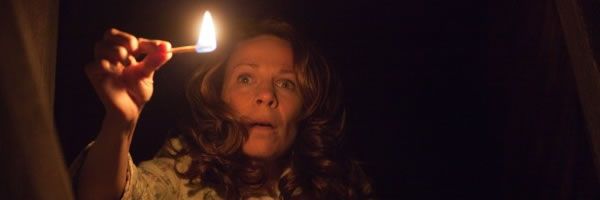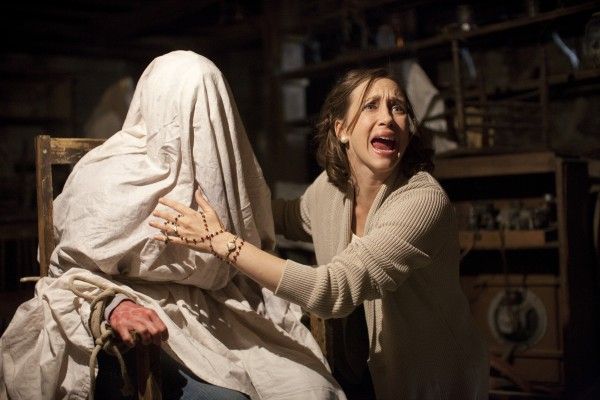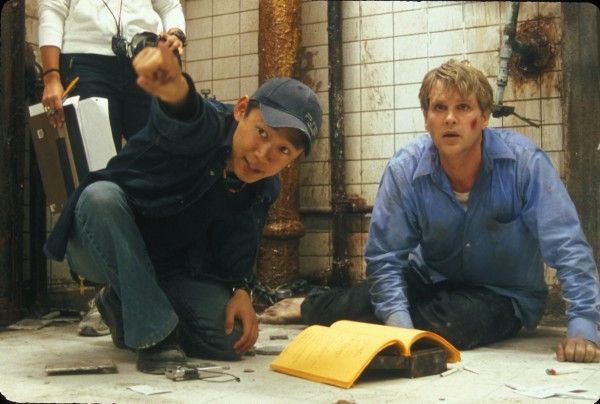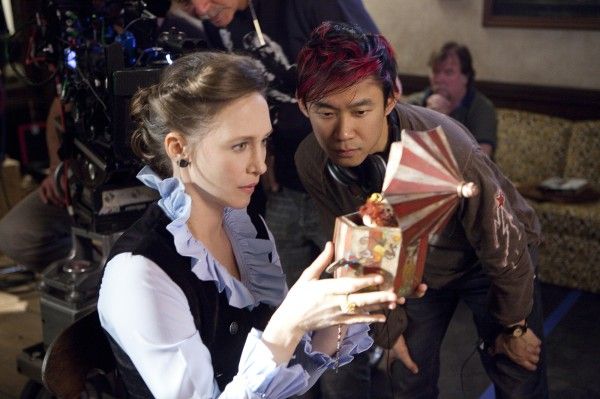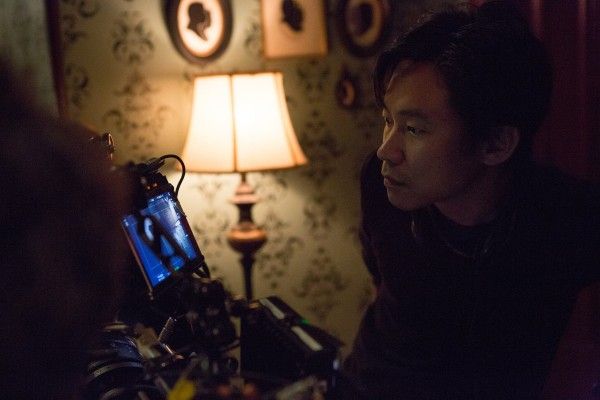The last few years have been really good for horror. The indie front has led the charge with recent standout films like The Babadook, It Follows, and The Witch, and regular contributions from exciting genre filmmakers like Ti West and Adam Wingard, among others. But even in what is proving to be such a rich market of genre filmmakers, there is perhaps no other director out there at the moment with a greater gift for horror set-pieces than James Wan.
Wan announced himself as a formidable voice in the horror scene back in 2004 with his stateside debut Saw, the unexpected hit that spawned not only a lasting franchise, but (along with Hostel), the once hugely popular "torture porn" subgenre. Since then, he's refined his craft with each new entry on his resume, and while not all of them measured up as great films, they were all stamped with Wan's unique visual slant and propensity for stomach-churning scares. His two best horror films to date, Insidious and The Conjuring, are so packed with stunning set-pieces, they probably could have spawned a Top 10 list a piece, but I've tried to cull the standouts down to the very best of the best. Of course, fear is subjective, but in terms of craftsmanship, these are ten scenes that prove Wan is one of the best in the biz. Check them out (preferably with the lights out and the volume up) in the list below.
10. The Corpse of Mary Shaw
One of Wan's shortest and simplest scare sequences, the reveal of the villainous Mary Shaw's ghastly corpse doesn't hinge on suspense or pacing the way his more refined set pieces do, but straight up shock and terror. A local urban legend, the ventriloquist Mary Shaw captured children to make "the perfect doll", and when the residents took violent retribution by cutting out her tongue and leaving her to die, Shaw became a vengeful spirit that lived on in the bodies of her grotesque dummies. Long before the events of the film, just after Mary Shaw's murder, the mortician's young son has a horrifying experience with her dead body as it tumbles out of the casket, her jaw hinged like one of her dolls. One Wan's early works, Dead Silence might be his one truly bad movie, but scenes like this one show the promise of his talent for supernatural moments of terror, and even more so, his knack for framing a scene around one truly terrifying ghoulish visage.
9. Into The Further
Insidious' third act diversion to the world of the dead left a lot of viewers cold, who felt the sudden transition drained the film of the slow-burn build of paranormal torment that made the first hour such a piano-wire taut thrillfest. However, opening up the world of The Further also opened up the Insidious aesthetic, allowing Wan to go full tilt with disturbing, otherworldly imagery and ghoulish characters.
No segment better pays off that opportunity than the eerie, offbeat antiquated family of the dead sitting in their living room in total stillness. Well, almost total, and that's part of what makes the sequence so damn effective. The patriarch's wheezy whistling and the occasional gentle sway from their inanimate bodies threatens they might spring alive at any moment. A promise that pays off when Patrick Wilson's Josh inspects the mother up close, his face merely inches from hers, and her lantern-lit dead eyes slowly blink as Joseph Bishara's cacophonous score clangs loudly in the background. Capped with a sinister murder and a cherry-on-top dose of that unnerving imagery in the form of the grinning murderess, the foray into The Further is the perfect example of how Wan's impeccable sense of timing and eye for disturbing grins and grimaces can turn a no-budget film like Insidious into one of the most effective supernatural chills in recent memory.
8. The Lipstick-Faced Demon
Barbara Hershey's Momma Lambert has really been through the ringer in her years, besieged by paranormal spirits not only in her youth, but once again when her grandson inherits the gift and curse of her Josh's ability to astral project. When it's clear her family is in danger again, she reveals her tale of woe, filling Renai (Rose Byrne) and Josh in on the dangers ahead and recalling the baleful visions that woke her in the night. In the dreamworld, the scene is creepy enough thanks to the dark tracking shot that puts you in Lorraine's shoes as her voiceover teases the terrors ahead.Those terrors don't take long to manifest, as she turns into Dalton's bedroom, revealing a pitch-black demonic figure looming in the corner, his spindly fingers outstretched toward her helpless comatose grandson.
It's an effective nightmarescape on its own, but Wan punctuates the sequence with the famous image of the lipstick-faced demon popping up behind Josh in the real world. Throughout the entire sequence, as Josh listens intently to his mother's tale, Wilson is backed by what is almost literally a blank canvas in the form of a black-washed portrait behind him, the camera ever-so-slowly pushing in tighter and tighter. It's framing that invites a ghastly image to fill the space, preparing the unknowing audience (well, if you didn’t see the trailer,) for the scare just around the corner. It's a jump scare, which aren't the hardest to do, but Wan frames it so cleverly, you can't help be impressed.
7. Jigsaw's Big Reveal
Arguably the entirety of Saw is one big set-piece leading up the climatic final reveal. That dead guy in the middle of the room? Yeah, not dead. And not only that, he's the mastermind behind the whole deadly affair. It's Chekov's corpse, you just never knew it was going to pop off. The reveal pays off some earlier moments in the film, explaining how Jigsaw (Tobin Bell) was always one step ahead of his prisoners despite the elaborate nature of his plot, but more importantly, it offers a broad-scale extra dose of horror to the whole film with the sinking realization that our heroes never really had a chance. Loved by many as one of the best film twists in recent memory, Jigsaw's reveal not only served as the ultimate cap on the end of Saw's twisted narrative, but established him as an iconic horror villain whose gruesome deeds would ultimately outlive even him.
6. Tip Toe Through The Tulips
There is perhaps no other set piece that better demonstrates Wan's firm grasp of tone. Ostensibly, there's no reason the imagery in this scene should conjure up the stomach-churning dread it does – it's just a Newsies-looking little dude dancing to Tiny Tim -- but thanks to Wan's precise use of movement and framing, that jiving little specter is downright chilling. Wan sets up the scare with one of her signature tracking shots, following the beleaguered-by-spirits Renai Lambert through her household chores.
In a brilliant little trick, Wan first reveals the dancing boy in a blink-and-you'll miss it pan through the laundry room, his tiny little figure facing the wall, "time out" style, next to the coat rack. Even if you don't notice him, you can bet you saw him and primed your subconscious for something eerie to go down, and if you do notice him, it induces an outright jolt of adrenaline. Either way, by the time Renai spies him through the window, the stage has been set to turn what would normally be adorable into pure nightmare fuel.
5. Wanna Play Hide and Clap?
Wan's use of the Hide and Clap game throughout The Conjuring is a peak demonstration of why he's such a premier craftsman of horror set-pieces. Introduced as a favorite child's game in the Perron family, it's essentially Hide and Seek wherein the seeker wears a blindfold and the hider hints at their location through claps. It's a game rife with possibilities for terror, from the inherent creepiness in children's games (ashes ashes, we all fall down,) to the primitive sensory elements of putting on a blindfold, and Wan exploits that promise to its full effect.
The game is introduced with a hint of menace from the very first time we see it played, when it leads the family to discover the ominous boarded-up basement where very bad things are bound to happen. The second game of Hide and Clap ratchets up the tension when Lili Taylor's Carolyn Perron follows a series of claps that lead her, not to her daughter, but to a chilling apparition. Finally, the gag is paid off in full when Carolyn is trapped and terrified in the basement with only matches to light her way, a pair of greyed children's hands emerging from the darkness behind her – Clap. Clap. Scream. Even after multiple viewings, it gets me every time.
4. The Seance
The tricky thing about horror is the fact that so many of the standby set-pieces have been done to death, and perhaps none more so than the séance. You might have thought we'd seen it all when it came to calling on the dead, but much like scribe Leigh Whannell does with the general premise of Insidious, which subverts the conventional haunted house yarn into an original tale about the dangers of astral projection, Wan makes the séance set-piece entirely his own through the use of spectral tech – including one eerie-as-shit gas mask.
The Séance is set up in the previous scene, which introduces Lin Shaye's ebullient psychic Elise and her team of bickering assistants Specs (Whannell) and Tucker (Angus Sampson), revealing the way they work collaboratively; Tucker operates the machinery, Elise communes with the otherworldly, and Specs acts as her mouthpiece. But that formula has it's full moment of glory in the Séance, as Dalton cries for help from The Further, his pleas filtered through Elise's muffled rasps, frantically scrawled on to the page by Specs. As a sinister spirit takes over the channel of communication, the séance spins out of control, punctuated by flashing light bulbs. When all is said and done, Elise slips out of the mask, her brilliant spirit thoroughly dimmed, setting up just how tremendous a threat the Lambert's are aligned against. Even when a trope has become rote, Wan finds creative ways to amp up the tension and spin it into something fresh and frightening once more.
3. The Exorcism
(Sorry guys, there's no decent video of this scene, so you're just going to have to go watch the movie again to see it in all its glory.)
Much like the séance in Insidious, Wan had quite a large task at hand when he attempted to take on the classic exorcism horror trope in The Conjuring. In fact, it's perhaps an even greater challenge since The Exorcist established the all-time seminal and incomparable cinematic exorcism all the way back in 1973. But Wan was more than up to the task. However, Insidious and The Conjuring are two entirely different beasts, and here, Wan doesn't seek to subvert the tropes, but embrace them and embolden them.
Carolyn Perron's exorcism is, like the film at large, played for classical terror. No tricky lighting or gadgetry, just the eviscerating battle for a soul played out in the body of a mortal. The demonic host ravages Carolyn, turning her into a feral force of violence, and when she is tied to a chair, it shreds through her, blood staining the sheet that covers her. Here, Wan also displays a bit of his action sensibilities in the midst of the horror onslaught, bodies banging around in a fury as the chair levitates and crashes around. Even through the brutal and kinetically engaging effects, Wan has the sense to hinge the exorcism on the talent of his performers, Patrick Wilson and Vera Farmiga's accomplished paranormal investigators overcome by the devilish sights in front of them. It's a sequence that sells in every way, and a demonstration of a filmmaker in full command of his form.
2. Reverse Bear Trap
The set-piece that spawned a tireless franchise. Despite the reputation it earned as shock-factor torture porn thanks to the increasingly reductive format of the sequels, Saw is essentially a thriller with hints of outright violence and shockingly little gore. But in the infamous reverse bear trap sequence, which recalls Amanda's (Shawnee Smith) tale of terror at the hands of Jigsaw, you can see the blueprint for what the Saw franchise would eventually become.
Amanda, a strung-out addict Jigsaw deems is taking her life for granted, wakes in a dreary room with an enormous metal contraption wired to her jaw. Jigsaw's gravely voice intones the rules of her game: she has to cut the key out of her "dead" cellmate in order to tear the bear trap off her face, or it will rip her head open at the jaw in what one imagines would be a most gruesome fashion. I say image, because unlike the Saw predecessors, which ultimately deliver on that grisly imagery, Wan has the restraint to depict the damage through a demonstration on a styrofoam bust, letting your mind fill in the nasty bits. The sequence lays the groundwork for the franchise, not just in the brutality of the trap, but introducing the horrific Jigsaw puppet, the saturated green-tinged color palette, and the frantic editing that would ultimately become trademarks of the series. Even with the countless, increasingly-horrific traps that would follow in the subsequent films, Amanda's reverse bear trap remains the most iconic and most effective.
1. There's Someone Behind The Door
A bit of pure horror genius, this set piece from The Conjuring is Wan's peak moment of terror and a testament to the value of finely-tuned filmmaking over gruesome effects and jump scares. As plenty of other entries on the list have proved, Wan has a tremendous talent for unsettling imagery, but here, he demonstrates ultimate control, building a suffocating sense of dread and letting a remarkable performance from the young Joey King do the rest.
In a moment that will make anyone who's ever experience sleep paralysis cringe in fear, King's Christine is awakened by a relentless tugging at her legs. Jolted from her sleep, she peers around and under the bed, Wan channeling that childhood fear we've all experienced as she steels herself to peer below the mattress. But nothing jumps out, there is no immediate release. Instead, the dread continues to build as Christine spies something so horrific behind the door that she's petrified at the spot, desperately calling to her nearby sleeping sister, Nancy (Hayley McFarland), in whispers. It feels like something pulled out of the most universal nightmares, and that sense of dream logic continues when Nancy awakens, unable to see the ghoul. Christine's terror grows by the second, her trembling hand pointing to the dark corner where the unknown, unseen threat lies in wait. When Nancy walks over to show her little sister everything's alright, Christine's panic reaches a peak as she chokes out "It's right behind you," the door slamming shut. All the while, we see nothing, but we feel everything. It's pure celluloid terror, proof that the imagination is always greater than the grisly, and the apex of Wan's ability dole out scares with the confident hand of a true craftsman.

